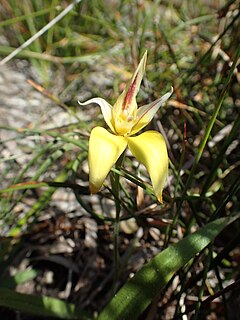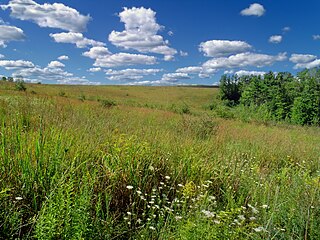
Caladenia attingens, commonly known as mantis orchids, are plants in the orchid family Orchidaceae and are endemic to the south-west of Western Australia. There are three subspecies, each of which has a single hairy leaf and one or two brightly coloured flowers with upswept sepals and a labellum with long, comb-like fringes. The subspecies differ in size, distribution and habitat.

Caladenia bicalliata subsp. bicalliata, commonly known as the limestone spider orchid or dwarf limestone spider orchid, is a plant in the orchid family Orchidaceae and is native to the south-west of Western Australia and coastal areas of South Australia. It has a single erect, hairy leaf and one or two cream-coloured flowers with reddish-brown tips.

Caladenia cruscula, commonly known as the reclining spider orchid is a species of orchid endemic to a small area in the south-west of Western Australia. It has a single hairy leaf and a single cream-coloured flower with a long red fringe on the sides of its labellum.
Caladenia denticulata subsp. albicans, commonly known as the alabaster spider orchid, is a plant in the orchid family Orchidaceae and is endemic to the south-west of Western Australia. It has a single erect, hairy leaf and one or two pale creamy-white flowers which have a white labellum with red markings. The only known population occurs in a small area near Arrowsmith.

Caladenia excelsa, commonly known as the giant spider orchid, is a species of orchid endemic to a small area in the south-west of Western Australia. It is a rare species with a single, hairy leaf and up to three cream-coloured to greenish-cream flowers with long, drooping sepals and petals. It is one of the tallest spider orchids in Western Australia and, with Caladenia splendens, has the largest flowers of any Western Australian orchid.
Caladenia exilis subsp. exilis, commonly known as the salt lake spider orchid, is a plant in the orchid family Orchidaceae and is endemic to the south-west of Western Australia. It is a relatively common spider orchid with a single erect, hairy leaf and up to three white to greenish-cream flowers with a small white, red-striped labellum.
Caladenia exilis subsp. vanleeuwenii, commonly known as the Moora spider orchid, is a plant in the orchid family Orchidaceae and is endemic to the south-west of Western Australia. It is a relatively rare spider orchid with a single erect, hairy leaf and up to three variably-coloured flowers with a small white, red-striped labellum. It differes from subspecies exilis in having variably coloured flowers, different growth habit, earlier flowering and different habitat.

Caladenia flava subsp. sylvestris, commonly known as the karri cowslip orchid, is a species of orchid endemic to the south-west of Western Australia. It has a single, hairy leaf and up to three pale yellow and cream-coloured flowers which are white near the tips of the sepals and petals and marked with bright red or pink.

Caladenia hirta subsp. hirta, commonly known as the sugar candy orchid or candy orchid, is a plant in the orchid family Orchidaceae and is endemic to the south-west of Western Australia. It has a single leaf and up to three creamy-white or pink flowers with brownish tips and a brown back.

Caladenia horistes, commonly known as the cream spider orchid is a species of orchid endemic to the south-west of Western Australia. It has a single, hairy leaf and one or two, creamy-yellow flowers which have a red-striped labellum and long, dark, thread-like tips on the sepals and petals.

Caladenia applanata subsp. applanata, commonly known as the broad-lipped spider orchid, is a species of orchid endemic to the south-west of Western Australia. It is a relatively common orchid with a single erect, hairy leaf and up to three flowers which may be red, cream, green or yellow and have a broad, flattened, red-tipped labellum.
Caladenia pendens subsp. pendens, commonly known as the pendant spider orchid, is a plant in the orchid family Orchidaceae and is endemic to the south-west of Western Australia. It has a single hairy leaf and up to three relatively large, creamy-white flowers with long drooping petals and sepals and sometimes has a sickly-sweet scent.

Caladenia pendens subsp. talbotii, commonly known as Talbot's spider orchid, is a plant in the orchid family Orchidaceae and is endemic to the south-west of Western Australia. It has a single hairy leaf and one or two white, red and yellow flowers with long drooping petals and sepals and sometimes has a citrus-like scent.
Caladenia pholcoidea subsp. pholcoidea, commonly known as the Albany spider orchid, is a plant in the orchid family Orchidaceae and is endemic to the south-west of Western Australia. It has a single hairy leaf and up to four pale yellow flowers with long drooping petals and lateral sepals.
Caladenia pholcoidea subsp. augustensis, commonly known as the Augustus spider orchid, is a plant in the orchid family Orchidaceae and is endemic to the south-west of Western Australia. It is a rare orchid with a single hairy leaf and up to three mostly white flowers with long spreading petals and lateral sepals.
Caladenia postea, commonly known as the dark-tipped spider orchid, is a species of orchid endemic to the south-west of Western Australia. It has a single erect, hairy leaf and up to three small, pale creamy-white flowers. It has a relatively late flowering period compared to similar spider orchids.
Caladenia remota subsp. remota, commonly known as the outback spider orchid, is a plant in the orchid family Orchidaceae and is endemic to the south-west of Western Australia. It has a single hairy leaf and one or two relatively large creamy-white to pale yellow flowers. It is relatively common in moist soil around granite outcrops, growing in more inland areas than most other spider orchids.

Caladenia uliginosa subsp. uliginosa, commonly known as the dainty spider orchid, or darting spider orchid is a plant in the orchid family Orchidaceae and is endemic to the south-west of Western Australia. It has a single hairy leaf and up to four greenish-cream flowers which have a forward-projecting labellum with a dark red tip.

Caladenia uliginosa subsp. patulens, commonly known as the frail spider orchid, is a plant in the orchid family Orchidaceae and is endemic to the south-west of Western Australia. It has a single hairy leaf and up to three greenish-cream flowers which have a forward-projecting, white labellum.
Caladenia xantha, commonly known as the primrose spider orchid, is a species of orchid endemic to the south-west of Western Australia. It has a single erect, hairy leaf and up to three yellow flowers with a cream-coloured, brown-striped labellum.





















